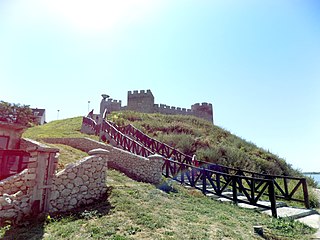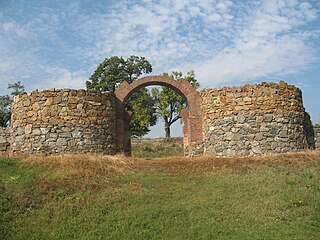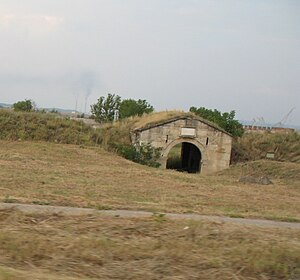
The Iron Gates is a gorge on the river Danube. It forms part of the boundary between Serbia and Romania (north). In the broad sense it encompasses a route of 134 km (83 mi); in the narrow sense it only encompasses the last barrier on this route, just beyond the Romanian city of Orșova, that contains two hydroelectric dams, with two power stations, Iron Gate I Hydroelectric Power Station and Iron Gate II Hydroelectric Power Station.

The siege of Belgrade, or siege of Nándorfehérvár was a military blockade of Belgrade that occurred 4–22 July 1456 in the aftermath of the fall of Constantinople in 1453 marking the Ottomans' attempts to expand further into Europe. Led by Sultan Mehmed II, the Ottoman forces sought to capture the strategic city of Belgrade, which was then under Hungarian control and was crucial for maintaining control over the Danube River and the Balkans.

The Belgrade Fortress, consists of the old citadel and Kalemegdan Park on the confluence of the Sava and Danube rivers, in an urban area of modern Belgrade, Serbia. Located in Belgrade's municipality of Stari Grad, the fortress constitutes the specific historical core of the city. As one of the most important representatives of Belgrade's cultural heritage, it was originally protected right after World War II, among the first officially declared cultural monuments in Serbia. The fortress was declared a Monument of Culture of Exceptional Importance in 1979, and is protected by the Republic of Serbia. It is the most visited tourist attraction in Belgrade, with Skadarlija being the second. Since the admission is free, it is estimated that the total number of visitors is over 2 million yearly.

Trajan's Bridge, also called Bridge of Apollodorus over the Danube, was a Roman segmental arch bridge, the first bridge to be built over the lower Danube and one of the greatest achievements in Roman architecture. Though it was only functional for 165 years, it is often considered to have been the longest arch bridge in both total and span length for more than 1,000 years.

Đerdap National Park stretches along the right bank of the Danube River from the Golubac Fortress to the dam near Novi Sip, Serbia. It was established in 1974 and spreads on 63,786.5 ha. The park management office is in the town of Donji Milanovac on the Danube. Across the river is the Parcul Natural Porțile de Fier in Romania.

Kladovo is a town and municipality located in the Bor District of eastern Serbia. It is situated on the right bank of the Danube river. The population of the town is 8,913, while the population of the municipality is 20,635.

Petrovaradin Fortress, nicknamed "Gibraltar on/of the Danube", is a fortress in the town of Petrovaradin, itself part of the City of Novi Sad, Serbia. It is located on the right bank of the Danube river. The cornerstone of the present-day southern part of the fortress was laid on 18 October 1692 by Charles Eugène de Croÿ. Petrovaradin Fortress has many tunnels as well as 16 kilometres (9.9 mi) of uncollapsed underground countermine system.

The Golubac Fortress was a medieval fortified town on the south side of the Danube River, 4 km (2.5 mi) downstream from the modern-day town of Golubac, Serbia. According to recent discoveries, the fortress, which was built during the 14th century by Medieval Serbian state, is split into three compounds which were built in stages. It has ten towers, most of which started square, and several of which received many-sided reinforcements with the advent of firearms. Towers were not connected for easier defense. Serbian Medieval frescos were recently found inside the fortress.

The Ram Fortress is a 15th century fort situated on a steep slope on the right bank of the Danube, in the village of Ram, municipality of Veliko Gradište, eastern Serbia. The fortress is located on a rock, which is from the northeast side tilted towards the Danube. It is assumed that the city was built on the opposite side from Haram fortress, which was located across the Danube and left no remnants. The remains of the city are in good condition.

The Smederevo Fortress is a medieval fortified city in Smederevo, Serbia, which was the temporary capital of Serbia in the Middle Ages. It was built between 1427 and 1430 on the order of Despot Đurađ Branković, the ruler of the Serbian Despotate. It was further fortified by the Ottoman Empire, which had taken the city in 1459.

The Moesian Limes is the modern term given to a collection of Roman fortifications between the Black Sea shore and Pannonia, present-day Hungary, consisting primarily of forts along the Danube to protect the Roman provinces of Upper and Lower Moesia south of the river.

The Danube is the second-longest river in Europe, after the Volga in Russia. It flows through much of Central and Southeastern Europe, from the Black Forest south into the Black Sea. A large and historically important river, it was once a frontier of the Roman Empire. In the 21st century, it connects ten European countries, running through their territories or marking a border. Originating in Germany, the Danube flows southeast for 2,850 km (1,770 mi), passing through or bordering Austria, Slovakia, Hungary, Croatia, Serbia, Romania, Bulgaria, Moldova, and Ukraine. Among the many cities on the river are four national capitals: Vienna, Bratislava, Budapest, and Belgrade. Its drainage basin amounts to 817,000 km² and extends into nine more countries.

The Walled City of Jajce is a medieval fortified nucleus of Jajce in Bosnia and Herzegovina, with Jajce Citadel high above town on top of pyramidal-shaped steep hill, enclosed with approximately 1,300 metres (4,300 ft) long defensive walls,. It is one of the best preserved fortified capitals of the Bosnian Kingdom, the last stronghold before the kingdom dissolved under the pressure of military advancement at the onset of Ottoman Empire takeover.

The Diana Fortress is a Roman castrum built in 100-101 AD, located in Kladovo, in eastern Serbia.

Bač Fortress is a medieval fortress in Vojvodina, Serbia. It is located in the town of Bač, in the Bačka region.

Žrnov or Žrnovan (Жрнован) was a medieval fortress on the highest top of the Avala Mountain, at 511 metres (1,677 ft), in Belgrade, Serbia. The Ancient Romans had built an outpost there, and later the Serbs expanded it into a fortress. It was completely demolished in 1934 to make the way for the Monument to the Unknown Hero.

Tekija is a village in the municipality of Kladovo in eastern Serbia. According to the 2002 census, the village has a population of 967 people.

Kurvingrad or Koprijan (Копријан), is a ruined fortress which sits above the town of Doljevac on the South Morava river, 11 km south of the town of Niš. The ruins are all that remain of the medieval town of Koprijan from the time of Classical antiquity; the fortress is over a thousand years old. Today, fortifications remain, but have not been substantially studied.

The Caviar of Kladovo was a type of caviar produced in eastern Serbia. It was named after the town of Kladovo, in central Serbia, part of the Danube's Iron Gates Gorge between Serbia and Romania. Made from various fishes' roe, the caviar was granted the protected geographic designation and was considered an expensive delicacy, which was even served on the RMS Titanic. With the construction of large dams in 1972 and 1984, jointly by the two states, the fish migrating from the Black Sea upstream the Danube were prevented from reaching their old spawning areas, and production of caviar was discontinued in the 21st century.

Zindan Gate is one of the gates in the complex of Belgrade Fortress, historical core of Belgrade, the capital of Serbia. It was built in the time when fortifications were switching from cold weapons to artillery, and when first cannons were introduced in the defense. Finished between 1440 and 1456, due to its unique appearance among the fortress' gates, and the 1930s reconstruction and upgrade in the Romanticist style, the medieval barbican is one of the landmarks of the fortress, and one of its most recognizable parts.

























